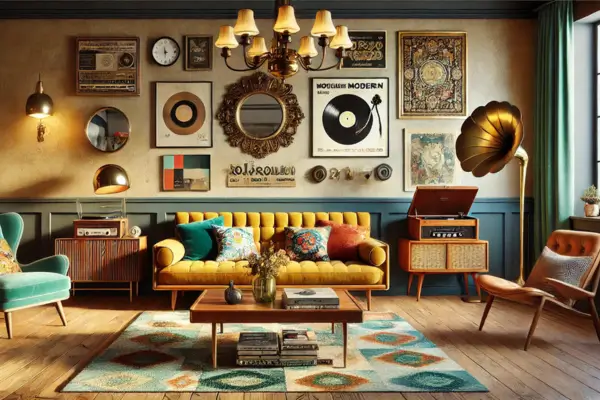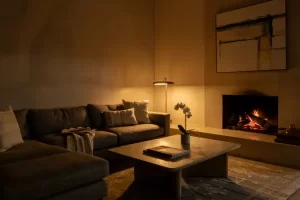Retro style decor is all about nostalgia meeting innovation—a design choice that celebrates the past while embracing modern sensibilities. Whether you’re drawn to the glamour of the 70s or the clean lines of mid-century furniture, the retro aesthetic allows you to tell a visual story through contrast and harmony. In today’s homes, mixing old and new is not just a trend—it’s a transformative way to express personal style with timeless charm.
Understanding Retro Style in Interior Design
Retro style decor refers to the use of design elements popular from the 1950s to the 1980s. This era introduced iconic silhouettes, bold color palettes, and materials like formica, vinyl, and teakwood. While retro pieces are rooted in the past, their striking shapes and patterns make them surprisingly relevant in modern interiors.
Key Characteristics of Retro Style
Retro interiors typically feature geometric prints, earthy tones mixed with bold primaries, and low-profile furniture with tapered legs. Think avocado greens, mustard yellows, and burnt oranges paired with walnut cabinets and colorful ceramics. The emphasis is on playful contrasts, curves, and texture.
Retro vs. Vintage: What’s the Difference?
Though often used interchangeably, retro and vintage have different meanings in interior design. Retro style references a specific design period, often recreated using new materials or manufactured items. Vintage, on the other hand, involves actual pieces from the past, adding authenticity and history to a space. Mixing the two can add both flair and depth.
Why Blend Retro with Modern?
Blending retro with modern design allows for a space that feels curated rather than themed. It prevents a room from becoming a time capsule, offering instead a dynamic balance that celebrates heritage while remaining grounded in present-day comfort and convenience.
The Benefits of Contrast
Combining the softness of mid-century sofas with the clean lines of modern cabinetry brings out the best in both worlds. The result is a design that is visually interesting and emotionally engaging. Retro shapes create familiarity and comfort, while modern finishes add sophistication and ease of use.
Creating Timeless Appeal
Retro-modern fusion never feels dated. While trends fade, the mixture of old and new ensures your decor remains adaptable. Changing a color scheme or updating artwork is easy when the foundation of your room is rooted in a flexible and balanced design aesthetic.
Choosing the Right Furniture
Furniture is the backbone of any interior, and in retro decor, it plays an essential role in setting the tone. Choosing pieces that hint at the past but meet today’s functional needs is key to executing a successful design blend.
Iconic Mid-Century Modern Pieces
Invest in timeless furniture such as Eames lounge chairs, Saarinen tulip tables, or Arne Jacobsen egg chairs. Their sculptural forms stand as focal points in any room while easily complementing newer elements like glass coffee tables or minimalist shelving.
Pairing with Modern Essentials
To avoid going full retro, pair vintage-inspired furniture with sleek, modern items. For instance, a retro credenza might sit beneath a wall-mounted smart TV. A velvet sofa in a retro hue like mustard or teal can be grounded with a modern, neutral rug and a contemporary floor lamp.
Color Palettes That Combine Old and New
The right color palette is essential in blending retro with modern. Retro style often showcases bold, saturated colors, while modern interiors lean toward neutrals and monochromatic schemes. The key is to create a balance between the two, ensuring the room feels cohesive rather than chaotic.
Retro Color Staples
Incorporate hues such as burnt orange, avocado green, mustard yellow, and teal. These shades reflect the iconic design periods from the ’60s and ’70s. Use them in accent pieces like cushions, rugs, or cabinetry to keep the look lively without overpowering the space.
Neutral Modern Base
To balance bold retro tones, start with a neutral base—whites, creams, light grays, or soft taupes. Walls, flooring, and large furniture pieces in neutral shades act as a blank canvas that lets retro accents shine while maintaining a clean and spacious feel.
Decorative Accents and Accessories
Accessories are the easiest way to infuse a space with retro flair without a full renovation. Items such as vintage clocks, patterned vases, or rotary telephones instantly evoke nostalgia and charm. Carefully curated accents give personality to your space and enhance visual interest.
Wall Art and Prints
Choose art inspired by the retro era—geometric patterns, pop art, or typography posters. These visuals inject energy and personality into the room. Mix and match modern abstract canvases with vintage movie posters for a stylish, eclectic gallery wall.
Textiles and Rugs
Layering textures and patterns is a retro trademark. Use shag rugs, velvet throw pillows, or curtains with bold motifs. Mixing these tactile elements with modern fabrics—such as cotton or linen in solid tones—balances visual excitement with comfort and practicality.
Lighting Fixtures with Retro Appeal
Lighting can be a show-stopping element in a retro-modern design. Mid-century lighting is known for its sculptural qualities—think Sputnik chandeliers, arc floor lamps, and mushroom-shaped table lamps. These eye-catching designs bring artistic flair to any room.
Combining Form and Function
Retro lighting doesn’t just look great—it often features functional innovations ahead of its time. Pair these pieces with dimmer switches or LED bulbs to bring them into the 21st century. Opt for brass or matte black finishes to add a modern edge to the vintage silhouettes.
Layered Lighting Approach
Create depth and ambiance by using a layered lighting strategy. Combine overhead lights with floor and table lamps. This not only highlights design features but also improves usability. Choose warm-toned bulbs for a nostalgic glow that enhances the retro feel of your decor.
Blending Furniture Styles for Harmony
One of the keys to a successful retro-modern space is curating furniture that represents both eras. Mixing pieces requires attention to proportion, scale, and balance. The goal is to avoid visual clutter while allowing each item to stand out for its unique design contribution.
Mid-Century Meets Minimalism
Mid-century furniture often features organic curves and tapered legs. Pair these with modern minimalist items that have clean lines and neutral tones. For instance, a vintage teak sideboard can sit harmoniously beneath a sleek wall-mounted television or abstract artwork.
Repurposing and Upcycling
Give new life to old pieces by repainting or reupholstering them in modern fabrics or finishes. This technique allows you to maintain the silhouette of a vintage chair while refreshing its visual appeal to match a contemporary color scheme. It’s a sustainable approach that adds character to your interior.
Retro Style in Different Rooms
You can apply retro-modern design across various spaces in your home. Each room offers unique opportunities to express this aesthetic through color, layout, and decor. Whether it’s a cozy living room, a creative home office, or a tranquil bedroom, the charm of retro style adapts beautifully.
Living Room Accents
In the living room, create a focal point with a retro sofa in a bold color or geometric print. Combine it with modern coffee tables, modular shelving, and minimalist lighting. Add a record player or vintage books for a touch of nostalgia that invites conversation and comfort.
Retro Office Spaces
Bring personality into your workspace by mixing a vintage desk with a contemporary office chair. Use bright desk accessories and colorful organizers to energize the space. Abstract prints, cork boards, and task lamps with retro silhouettes keep the area practical and stylish.
Bedrooms with Timeless Charm
For bedrooms, focus on warm wood tones and soft fabrics. A retro bedframe or nightstand combined with modern linens and simple lighting creates a cozy retreat. Accent the room with vintage wall clocks, patterned cushions, or velvet throws to enhance the atmosphere of relaxed sophistication.
Balancing Functionality and Nostalgia
It’s easy to get swept up in the charm of retro design, but it’s important to keep functionality in focus—especially in high-use areas like kitchens and bathrooms. Select pieces that provide modern convenience while visually nodding to the past. Practical design shouldn’t be sacrificed for aesthetic appeal.
Appliances with Retro Appeal
Many brands now offer kitchen appliances that mimic retro aesthetics—think pastel-colored refrigerators, toasters, and mixers with chrome details—while offering today’s technology. These pieces are perfect for maintaining visual continuity without compromising performance.
Smart Design in Small Spaces
In small homes or apartments, choose multipurpose furniture that includes retro style with modern functionality. A vintage console table can double as a desk, while a retro bar cart adds storage and visual interest. Prioritize pieces that make the most of your square footage.
Final Touches That Bring the Look Together
The success of a retro-modern space often lies in the finishing details. Accessories, art, and styling bring cohesion and depth. These elements should echo the overall theme without overwhelming the space or clashing with other pieces. The key is intentional curation—every item has a purpose, whether functional or decorative.
Retro Art and Wall Decor
Wall art is a powerful tool for establishing the mood of a room. Opt for vintage posters, pop art prints, or abstract geometric shapes reminiscent of the 50s and 60s. Use gallery walls to blend retro frames with minimalist arrangements for a look that bridges time periods with flair.
Layering Textiles and Rugs
Textiles add comfort, texture, and color. Incorporate patterned rugs with bold or earthy tones to anchor a room. Pair these with curtains, cushions, and throws that reflect retro motifs such as chevrons, dots, or atomic starbursts. Don’t hesitate to mix textures—velvet, linen, and leather can coexist beautifully.
Accessories with Character
Finish your décor with carefully selected accessories. Think sculptural vases, vintage clocks, retro table lamps, or ceramic figurines. These seemingly small details tie the design together and add a layer of authenticity. A well-chosen centerpiece or lighting fixture can elevate the entire room’s atmosphere.
Conclusion: Embrace the Timeless Charm of Retro Style
Retro style décor offers an opportunity to celebrate the past while embracing the present. With a thoughtful blend of vintage charm and modern refinement, your home can become a reflection of both nostalgia and forward-thinking design. The key lies in balance—between color and neutrality, form and function, and memory and innovation.
Whether you’re starting with a single accent piece or redesigning an entire room, retro-modern decorating allows endless room for creativity. By layering textures, honoring vintage aesthetics, and incorporating contemporary comforts, you’ll craft a space full of warmth, character, and timeless appeal.
Ready to transform your home with retro flair?
Start with one room and let the charm of the past guide your modern creativity. From mid-century silhouettes to playful patterns and colors, each choice adds personality to your interiors. Embrace the mix, and design a home that tells your story with style!




